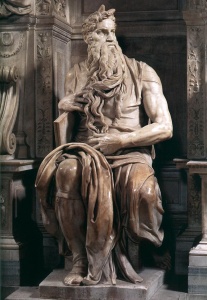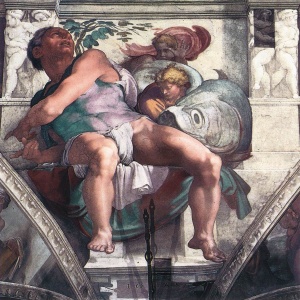Michelangelo and the Jews: Part II
The Sistine Secrets by Benjamin Blech and Roy Doliner raises many intriguing issues about one of the most important works of Western art and its creator, Michelangelo Buonarroti (1475-1564) as first presented in my review of August 29th. Now we shall attempt to put this masterpiece and the artist in a larger context.
Here is a brief summary of the frescos 65 feet above the floor on the Sistine ceiling that measures 46’ wide and 131’ long:
The shallow barrel vault rests on a series of round lunettes at the top of the walls that depict the Jewish Ancestors of Jesus; six panels on each side each showing two figures to represent salient figures named in plaques, such as Jesse, David, Solomon, etc. Above each is a triangular spandrel with a female dominated Jewish family associated with the ancestors below.
Above them on the ceiling proper are twelve painted architectonic thrones, each seating a dramatic and over-life size Hebrew prophet (Jeremiah, Daniel, Ezekiel, Isaiah, Joel; Zechariah is seated over the main entrance of the chapel while Jonah is over the altar) interspersed with five pagan sibyls. This alternating prophet / sibyl motif along with 20 seated male nudes known as ignudi frames the central narrative panels of the ceiling
The small and large narrative ceiling panels alternate across the long vault: God Dividing Light from Darkness; God Creating the Moon, the Sun and the Plants; God Separating the Waters from the Land; Creation of Adam; Creation of Eve; Temptation and Sin of Adam and Eve and the Expulsion from the Garden; the Sacrifice of Noah, the Victims of the Flood and Drunkenness of Noah. In the corners of the ceiling are the four salvations of Israel: Judith and Holofernes, David and Goliath, the Brazen Serpent of Moses and the Punishment of Haman.
Considering the visual complexity of this ceiling and our author’s radical claims of Kabbalistic and hidden Judaic content, we need to understand whether Michelangelo was really a philosemite trying to articulate and add an authentic Judaic vision to the Sistine ceiling or simply an appropriator of a handful of Judaic concepts to create a kind of artistic cholent mainly composed of Neo-Platonism, Catholicism and Greco-Roman paganism. Exactly because the distinction between these ideas is vital to us, our examination of Blech’s and Doliner’s assertions must demand that we make the crucial distinction between what is historically known about the artist’s intentions through primary documents, and our contemporary analysis on the work of art, specifically the critic’s own reading and opinion of the work of art. Both are equally valid but critically distinct from one another. As viewers we must always know the difference.
Notable is the predominance of the 20 seated male nudes, ignudi, in the pictorial scheme of the central ceiling. Twisting and turning in a constant variety of emotional poses, they effectively frame each of the scenes from Genesis and the bronze colored Biblical medallions. The term ignudi was invented by Michelangelo himself and represents his version of the idealized and eroticized nude male figure, a celebration of the Classical ideal that equates beauty with virtue, set here in immediate proximity with the Biblical narrative and the prophetic tradition. This juxtaposition would be radical enough if it were not for the fact that many of the figures in the narrative panels themselves were nude including numerous angels, Adam and Eve, the serpent, many of the victims of the flood, Noah and his sons, Holofernes and Haman. Whatever access Michelangelo had to Jewish texts and thought, the notion of modesty was clearly overlooked.
It should be noted that these issues were not overlooked by the generation that followed Michelangelo. The Council of Trent (1545-1563) was the Catholic reaction to the Protestant Reformation and they found these aspects of Michelangelo’s work deeply troubling. Before the great artist had died they ordered his friend Daniele da Volterra to cover up much of the most egregious nudity in the Last Judgment (painted by Michelangelo between 1536 and 1541 on the huge altar wall of the Sistine Chapel). A similarly censorious program on the ceiling was prevented by logistical problems with constructing a practical scaffold to reach the entire ceiling.
Even if we accept the premise that Michelangelo was deeply respectful and enamored of Jews and Jewish ideas in his frescos on the Sistine ceiling, two of his most famous sculptures, David and Moses, are deeply problematic from a Jewish point of view. The colossus David, twice life-size, was installed in 1504 in front of the Palazzo della Signoria in Florence, the very heart of a new found republican, anti-Medici and free city. Carved by the 24 year old Michelangelo out of one massive block of marble, the totally nude depiction of the young David about to confront Goliath is a proud Renaissance image of a Greco-Roman hero representing the city of Florence in her fight for liberty. Evidently it was admired by the Jews of Florence, no doubt as much proud that the greatest king of Israel was seen by the Florentines as their hero, as by the spectacle that he had been transformed into a goy; he was unmistakably depicted as uncircumcised. The authors contention that perhaps Michelangelo had never seen a circumcised man or was somehow afraid of the Inquisition’s possible charge of Judaizing fails to convince us of the artist’s deep and abiding respect for Jewish thought and concepts. It is much more likely that the great artist had little or no respect or interest in the meaning of the sign of the covenant each male Jew proudly accepts.

The similarly colossal Moses, carved right after Michelangelo finished the Sistine ceiling in 1515, is perhaps the most awesome vision of the prophet ever conceived. He sits poised to rise, grasping the tablets in his right hand as he turns and intensely gazes into the distant future. The great biographer of Renaissance artists, Vasari, comments that “…the Jews continue to go there (as they do every Sabbath, both men and women, like flocks of starlings) to visit and adore the statue, since they will be adoring something that is divine rather than human.” And what they saw, in spite of Blech’s and Doliner’s apologetic, was Moses with horns, the horns derived from Jerome’s mistranslation of this passage in the Bible and yet cherished by the medieval Christians as proof of the evil demonic nature of the Jewish people. Even if Michelangelo believed the horns were symbols of magical power, the Jews knew that the common folk saw them as a symbol of evil incarnate that doomed the Jews to eternal perdition for the crime of deicide.
Another problem with the premise of the Sistine Secrets is the very nature of secrets and hidden codes. To communicate a secret code one must have an audience who will understand it. The maxim of Ockham’s Razor (The simplest answer is usually the correct answer) must be applied to the explanations found in the Sistine Secrets.

Blech and Doliner argue at length that the dramatic figure of Jonah is embedded with many secret signals and meanings, indeed they see the Hebrew letter “hay” in the positioning of the prophet’s legs, echoed by the youth behind him holding up his five fingers, signifying that the primacy of the five books of Moses must be observed by the corrupt papacy. Even Jonah’s twisted pose looking above is seen as a rejection of the Pope below. Furthermore they maintain that Michelangelo understood that Jonah also means a dove, thereby substituting a Hebrew dove for the traditional dove of the Christian holy spirit. All of this is possible, but totally speculation in comparison to the clear verse in the Gospel of Matthew that compares Jonah to Jesus, quoting Jesus saying that: “…For as Jonah was three days and tree nights in the belly of the whale; so shall the Son of man (Jesus) be three days and three nights in the heart of the earth” before the resurrection. It is a simple, direct Christian message to all visitors to the Sistine.
It is less than certain that any of the visitors of the Sistine understood the rather complex allusions to Hebrew letters, Talmudic references and Kabbalistic programs that the authors allege are present. Because of the historical silence concerning these images it would seem that no one understood these codes. On the contrary the only controversies the ceiling and the subsequent Last Judgment wall ignited was concerned with the egregious nudity of the figures. In fact it is quite plausible that the silence of 500 years may simply point to the fact that these hidden codes and allusions posited by Blech and Doliner are not there at all. While they are fascinating and even at times plausible, they may simply be wishful constructions similar to the forms of figures and faces found in transitory cloud formations. What we do know is that in the vast body of Michelangelo’s letters, documents and contemporary comments about the Sistine, the artist never voiced a clear expression of his intentions. More importantly, to posit the author’s speculations as other than simple opinion is to blatantly indulge in sensationalism.
When approaching any work of art it is prudent to assume that very little can be known with certainty about the artist’s intentions. Rather the historical setting and primary documents serve as a foundation to giving a critical contemporary reading of the artwork. Ultimately it matters little what the artist intended. After a work leaves the artist’s studio and especially after the artist is dead, the artwork is on its own to establish its meaning and convince the audience of its beauty.
As Michelangelo lay dying he summoned his close friends and assistants and ordered them to burn his remaining notes and drawings. His role as a creative artist was now ending and by closing the door on his life he ushered his artworks into a world of their own. The ideas and creativity of Michelangelo’s works our now our inheritance. We must treat them as precious gifts in themselves, not as convenient tools for our own designs.
Michelangelo and the Jews: Part II
The Sistine Secrets by Benjamin Blech & Roy Doliner
Harper Collins, New York: 2008